817 Search Results for praactical teaching
December 31, 2015
by Carole Zangari -

Goodbye, December! Before we turn the calendar page, here are some of the most popular posts of 2015. Many thanks to Lauren Enders, Rachael Langley, and all of our guest bloggers for being so generous with their time and expertise. I couldn’t do it without you!! 5 Great Resources for Pre-Made Communication Boards How I Do It: Writing IEP Goals for Students Who Use AAC with Lauren Enders How I Do It by Rachael Langley – PODD in the Classroom: Portable, Wearable, & Comfortable How I Do It: Using PODD books and Aided Language Displays with Young Learners with Autism Spectrum Disorder Core Samples Teaching Core Vocabulary A Year of Core Vocabulary Words Pivotal Skills for AAC Intervention: Aided Language Input Literacy for Everyone with Adapted Books Communication Boards: Colorful Considerations 30 Ways to Celebrate Autism Awareness Month
November 9, 2015
by Carole Zangari -
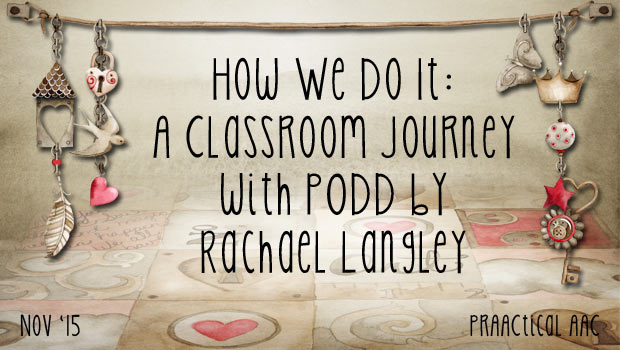
Let’s face it. Good AAC implementation takes commitment and requires a lot of effort from those who are with the AAC learners throughout the day. Sometimes an AAC tool or strategy that seemed promising at first, doesn’t pan out to be as successful as expected. Other times, it’s a challenge to keep up with the demands of the classroom, therapy session, and life and still find the energy to consistently implement good AAC practices. In the real world, teams struggle with these issues every single day. So when Rachael Langley, a Michigan-based SLP and AAC specialist, offered to provide insight into what that process has been like in classrooms she supports, I was thrilled. Rachael’s original post about using PODD in the classroom and her follow-up post on implementation tips gave us insight into the journey that one elementary school classroom team is taking to better serve their students with little or no... [Read More...]
November 2, 2015
by Carole Zangari -
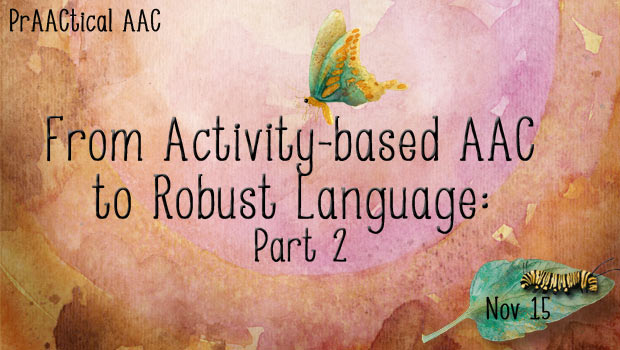
Last week, we talked a bit about activity-based communication displays (ABCDs), and the role they play for AAC learners. The analogy of feeding someone (with ABCDs) versus teaching them to fish for themselves (with robust AAC), resonated with many of you. In some cases, ABCDs can be a good way for therapists, educators, and families to take steps forward in their implementation of AAC. They allow students with little or no functional speech a way to participate in activities by making choices and comments, and that is a very good thing for those who don’t have a better option. There are a few drawbacks to ABCDs, though. Here are some of them. ABCDs limit language development. The learner can only experience the exact words and configurations that appear on a particular display. The learner has no way to expand his/her utterance by including other words or concepts. ABCDs are time-consuming... [Read More...]
October 28, 2015
by Carole Zangari -
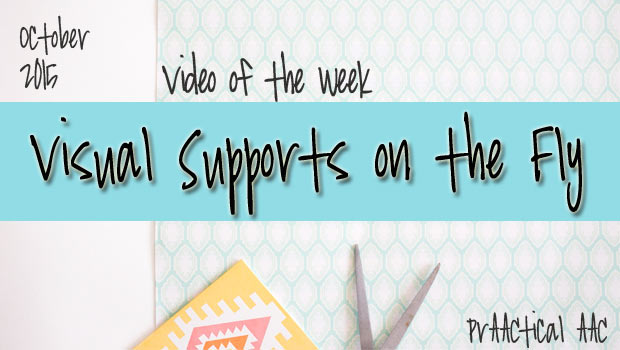
For several years, we’ve written many posts on the use of visual supports with AAC learners. One thing we haven’t talked about, though, is what to do when you’re in the midst of therapy or a lesson, and the need for an additional visual support arises. In this week’s featured video, SLP Shannon Hennig does an amazing job of explaining how she improvises to make visual supports on the fly. Like you, I appreciate the plethora of visual supports that have been appearing on Teachers Pay Teachers, SLP blogs, materials exchange sites, and Pinterest. Most of them are just adorable, some of them are well-designed, and all of them make using visual supports more convenient for busy professionals and families. In the end, though, the best visual supports are the ones that meet the needs of the situations. And, while we do our best to predict what will be needed... [Read More...]
October 27, 2015
by Carole Zangari -
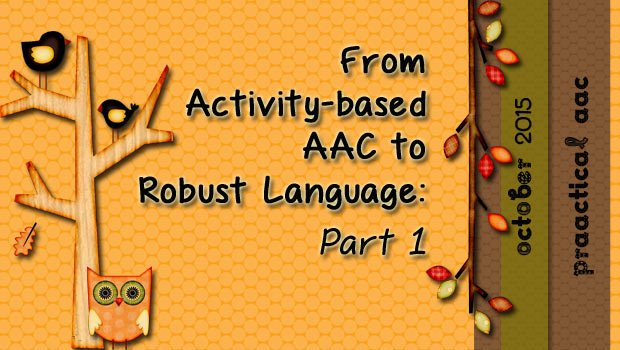
As far as I can tell, most AAC learners are taught by people who don’t specialize in AAC. Their school SLPs may have caseloads of 50, 60, 70, or more students with IEPs, 90% of whom have goals for articulation, language, and fluency. Their classroom teachers serve students whose disabilities range from none at all, to dyslexia to cerebral palsy, to significant intellectual disabilities, and everywhere in between. In all likelihood, neither group had much AAC training. What little AAC they know, they’ve picked up on their own from reading, going to workshops and conferences (usually self-funded), talking to colleagues, and exploring online resources. Many times, their first foray into AAC is with things like choice boards and visual supports, such as daily schedules and first/then boards. From there, they may begin labeling the environment with pictures symbols (e.g., ‘table’ on the table, ‘on/off’ near the light switch), using mini-schedules... [Read More...]
October 20, 2015
by Carole Zangari -
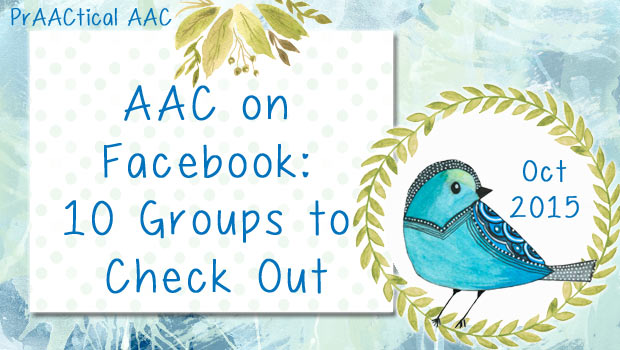
Have an AAC question that you need answered at 11:00 pm? Want to be alerted to discounts on AAC apps? Need some ideas for AAC teaching? Looking for a specific AAC assessment form? Have some time to encourage a family or professional who is new to AAC? Just got the news that you have a budget for equipment and want suggestions? Facebook is a great place to connect with like-minded individuals to converse about AAC and related topics. Most SGD companies and app developers have their own Facebook pages, so search for the ones that you use most frequently. Here are some of the more active AAC groups on Facebook that are not aligned to a specific device or app. AAC for the SLP AAC and AT Networking Augmentative Communication Resources and Help AAC: Alternative Awesome Communicators Rett Syndrome Communication Device and Information Exchange Angelman, Literacy, and Education (NOT limited... [Read More...]
October 13, 2015
by Carole Zangari -
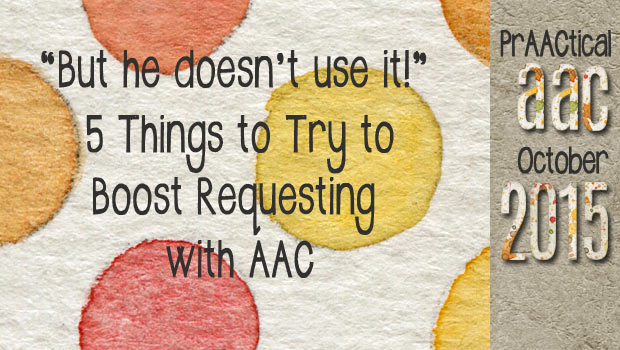
You did the assessment and got funding for the AAC device/app/aid. You regularly implement aided language input and your therapy is progressing nicely. You’ve spent time with teachers, paraprofessionals, family members, and others to educate them about AAC. You’ve worked with them to develop some initial goals around requesting wants/needs (even though that wasn’t your favorite place to start). You’ve identified some of his favorite things and even programmed language that allows him to request ‘something else’ if he doesn’t care for any of the choices. The foundation is set and things should be coming along. So what’s the problem? Well, it seems that the AAC learner hasn’t quite gotten the memo. Sigh. Rather than use the amazing AAC tool to ask for what he wants, Jonah continues to reach, grab, whine, and cry to get his needs met in most situations. Yes, progress is happening, but s-l-o-w-l-y. You have a... [Read More...]
September 17, 2015
by Carole Zangari -
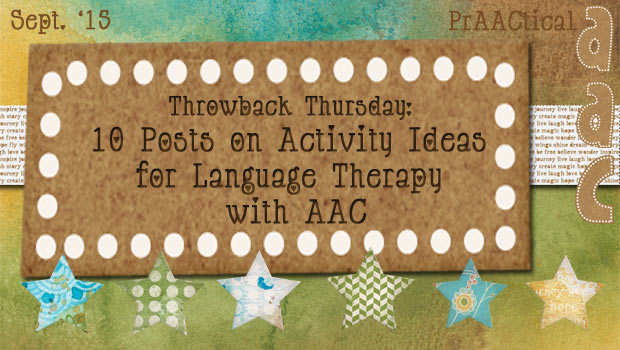
Great kid. Check! Appropriate AAC system. Check! Well-developed intervention goals. Check! Key intervention strategies. Check! Where do we go from here? Well, if you are anything like the young clinicians with whom I’ve been speaking, you might be thinking about therapy activities and materials. Here are some past posts that may be of interest. Magic Moments with Tellagami New Word Teaching: A Look Inside Some PrAACtical Therapy Sessions 5 Ways to Use Word Clouds in AAC Therapy and Magic Moments with Word Clouds Magic Moments: Painting with Time Teaching the Use of Social Phrases and Comments Let’s Go Outside! 5 PrAACtical Ideas Magic Moments with Disneyland Explorer “Can I Ask You a Question?” Language Experience Surveys 5 PrAACtical Thoughts on Catch-up Conversations Magic Moments with Sentence Builder
September 8, 2015
by Carole Zangari -
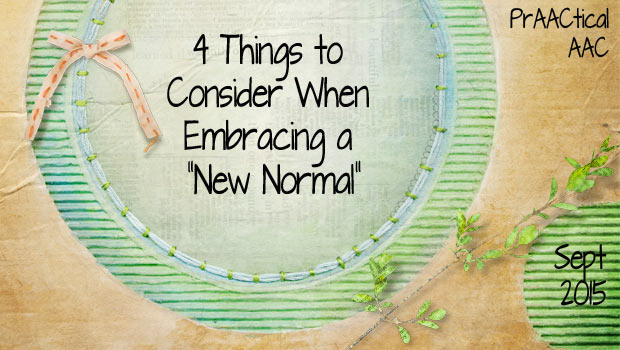
It isn’t every day that we get to hear from AAC interventionists who’ve been doing this work for decades. Today, we are thrilled to welcome back SLP Marlene Cummings from Oakland Schools in Michigan. Marlene has written several very popular posts on AAC in educational settings. (Click here to peruse them.) In this post, Marlene gets us thinking about ways to deal with change in a positive and sustainable fashion. Her passion for supporting both kids and colleagues is infectious. Enjoy! :::::::::::::::::::::::::::::::::::::::::::::::::::::::::::::::::::::::::::::::: I have the privilege, as part of a 5 member AAC Team, of supporting 28 school districts with more than 100 teams serving students with complex communication needs using AAC. The staff members and teams we support come with varied levels of knowledge, diverse experiences, and degrees of confidence. For us the new school year is just around the corner. We are already receiving calls and emails reporting... [Read More...]
September 7, 2015
by Carole Zangari -
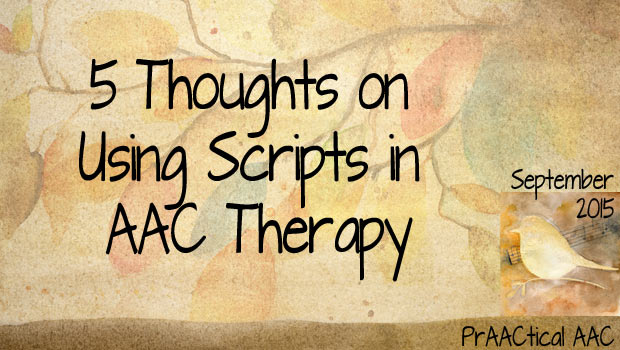
As we all know, it’s a big leap from having an AAC system to being able to use it functionally. For many of our prAACtical friends, one of the areas in which they struggle is conversation. It is no easy thing to have even a brief social interaction. We’ve written before about the use of scripting, a powerful strategy that we can use to help learners build conversational skills.` Scripts provide structure. As clinicians and educators, we understand that many of our learners do best when there is a clear beginning, middle, and end to an activity. For many people learning to use AAC, conversation is a VERY challenging thing because it can be quite amorphous. Scripting gives the learner practice getting comfortable with some of the skills that they need to use in conversation by adding the element of structure. The script has a clear starting point (e.g., “Look... [Read More...]









